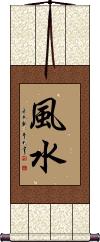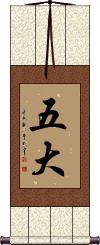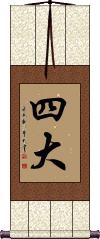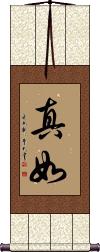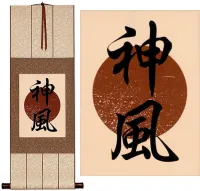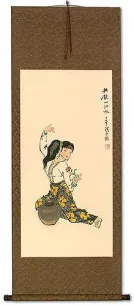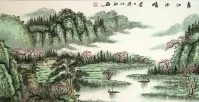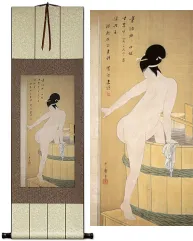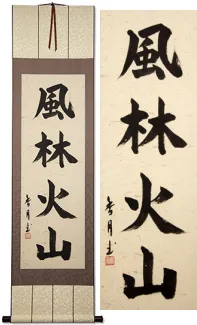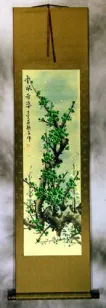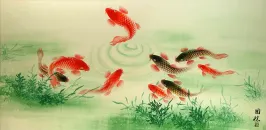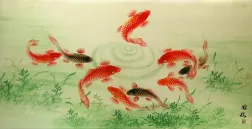Many custom options...
And formats...

The name Wind Water in Chinese / Japanese...
Buy a Wind Water calligraphy wall scroll here!
Personalize your custom “Wind Water” project by clicking the button next to your favorite “Wind Water” title below...
1. Feng Shui
Feng Shui
風水 is the famous technique and approach to arranging your home externally around natural features and internally to create balance and peace.
These two characters literally mean “wind water.” Obviously, the title is far more simple than the concept behind this subject.
It may enlighten you slightly to know that the character for “wind” can also mean style, custom, or manner in some contexts. This may apply somewhat to this title.
In a technical sense, this title is translated as Chinese geomancy.
Five Elements
地水火風空 is the specifically-Japanese version of the five elements.
This is a little different than the ancient or original Chinese version.
The elements are written in this order:
1. Earth / Terra / Ground
2. Water
3. Fire
4. Wind / Air
5. Sky / Emptiness / Void / Ether
Note: This set of Kanji can also be romanized as “ji sui ka fuu kuu,” “jisuikafuukuu,” or “jisuikafuku.”
These can also be written in the order 地火風水空 (chi ka sui fuu kuu). Let me know when you place your order if you want the Kanji to be in this character order.
Four Elements
Buddhist Term
地水火風 is a Buddhist term that means “earth, water, fire, wind.”
This is often just referred to as “the four elements.” There is a more common title (the five elements) that adds wood to the mix. These four elements are used in some sects of Japanese Buddhism (not so much in Chinese).
Godai / Five Elements
五大 is the Japanese title for the five elements.
In Japan, the five elements differ slightly from the original Chinese. Therefore, in Japanese philosophy, you have earth, water, fire, wind, and void (space).
The meaning of the first character is 5, but the second character means great or large. Some translate this as the five majors. 大 is only understood as “elements” when you have 五 in front of it.
In Buddhism, this can be short for 五大明王, or the five great and wise kings.
Shidai / Sida / Mahabhuta
In Mahayana Buddhism, 四大 represents mahābhūta, the four elements of which all things are made: earth, water, fire, and wind.
This can also represent the four freedoms: speaking out freely, airing views fully, holding great debates, and writing big-character posters.
In some contexts, this can be a university or college offering four-year programs.
To others, this can represent the Tao, Heaven, Earth, and King.
Going back to the Buddhist context, these four elements “earth, water, fire, and wind,” represent 堅, 濕, 煖, 動, which are: solid, liquid, heat, and motion.
Tathata / Ultimate Nature of All Things
真如 comes from the Sanskrit and Pali word often romanized as “tathata” or “tathatā.” Originally written, “तथता.”
It's a Buddhist term often translated as “thusness” or “suchness,” but this does not explain it.
A better explanation may be “the ultimate nature of all things” or “ultimate truth.” However, this gives it too strong of a feeling. This concept is sometimes described as being in awe of the simple nature of something - like a blade of grass blowing in the wind or ripples on water. It is what it is supposed to be, these things follow their nature. Amazing in their mundane simplicity.
Every sect of Buddhism will have a slightly different flavor or explanation, so don't get fixated on one definition.
Notes: Sometimes Buddhists use the word dharmatā, a synonym to tathatā.
In Japan, this can also be the female given name Mayuki, or the surname Majo.
This in-stock artwork might be what you are looking for, and ships right away...
Gallery Price: $144.00
Your Price: $79.88
Gallery Price: $83.00
Your Price: $45.88
Gallery Price: $240.00
Your Price: $98.88
Gallery Price: $400.00
Your Price: $138.88
Gallery Price: $400.00
Your Price: $138.88
Gallery Price: $108.00
Your Price: $59.88
Gallery Price: $121.00
Your Price: $66.88
Gallery Price: $200.00
Your Price: $122.88
Gallery Price: $72.00
Your Price: $39.88
Not the results for wind water that you were looking for?
Below are some entries from our dictionary that may match your wind water search...
| Characters If shown, 2nd row is Simp. Chinese |
Pronunciation Romanization |
Simple Dictionary Definition |
五大 see styles |
wǔ dà wu3 da4 wu ta godai ごだい |
More info & calligraphy: Godai / Five ElementsThe five elements— earth, water, fire, wind, and space. v. also 五行 the five agents. In the esoteric cult the five are the physical manifestation, or garbhadhātu, v. 胎; as being in all phenomena they are called 五輪 the five evolvers; their phonetic embryos 種子 are those of the Five Dhyani-Buddhas of the five directions, v. 五佛. |
四大 see styles |
sì dà si4 da4 ssu ta shidai しだい |
More info & calligraphy: Shidai / Sida / Mahabhuta(1) {Buddh} the four elements (earth, water, fire, wind); (2) the human body; (3) Tao, heaven, earth and king mahābhūta, 四界; 四大界. The four elements of which all things are made; or the four realms; i. e. earth, water, fire, and wind (or air); they represent 堅, 濕, 煖, and 動 solid, liquid, heat, and motion; motion produces and maintains life. As 實 active or formative forces they are styled 四界 (四大界) ; as 假 passive or material objects they are 四大; but the 成實論 Satyasiddhi śāstra disputes the 實 and recognizes only the 假. |
毒蛇 see styles |
dú shé du2 she2 tu she dokuja; dokuhebi どくじゃ; どくへび |
More info & calligraphy: Viperpoisonous snake; poisonous serpent A poisonous snake.; Poisonous snakes, the four elements of the body— earth, water, fire, wind (or air)— which harm a man by their variation, i. e. increase and decrease. Also, gold. |
風水 风水 see styles |
fēng shuǐ feng1 shui3 feng shui fuusui / fusui ふうすい |
More info & calligraphy: Feng Shui(1) feng shui; fengshui; (2) wind and water; (female given name) Fumi geomancy |
風輪 风轮 see styles |
fēng lún feng1 lun2 feng lun |
More info & calligraphy: Wind Wheel |
地水火風 地水火风 see styles |
dì shuǐ huǒ fēng di4 shui3 huo3 feng1 ti shui huo feng chisuikafuu; jisuikafuu / chisuikafu; jisuikafu ちすいかふう; じすいかふう |
More info & calligraphy: Four Elementsearth, water, fire, wind |
地水火風空 see styles |
chisuikafuukuu; jisuikafuukuu / chisuikafuku; jisuikafuku ちすいかふうくう; じすいかふうくう |
More info & calligraphy: Five Elements |
大 see styles |
dài dai4 tai dai だい |
see 大夫[dai4 fu5] (pref,adj-na,n) (1) large; big; great; huge; vast; major; important; serious; severe; (prefix) (2) great; prominent; eminent; distinguished; (suffix) (3) -sized; as big as; the size of; (suffix noun) (4) (abbreviation) (See 大学・1) university; (5) large (e.g. serving size); large option; (6) (abbreviation) (See 大の月) long month (i.e. having 31 days); (given name) Yutaka Maha. 摩訶; 麼賀. Great, large, big; all pervading, all-embracing; numerous 多; surpassing ; mysterious 妙; beyond comprehension 不可思議; omnipresent 體無不在. The elements, or essential things, i.e. (a) 三大 The three all-pervasive qualities of the 眞如 q.v. : its 體, 相 , 用 substance, form, and functions, v. 起信論 . (b) 四大 The four tanmātra or elements, earth, water, fire, air (or wind) of the 倶舍論. (c)五大 The five, i.e. the last four and space 空, v. 大日經. (d) 六大 The six elements, earth, water, fire, wind, space (or ether), mind 識. Hīnayāna, emphasizing impersonality 人空, considers these six as the elements of all sentient beings; Mahāyāna, emphasizing the unreality of all things 法空, counts them as elements, but fluid in a flowing stream of life, with mind 識 dominant; the esoteric sect emphasizing nonproduction, or non-creation, regards them as universal and as the Absolute in differentiation. (e) 七大 The 楞嚴經 adds 見 perception, to the six above named to cover the perceptions of the six organs 根. |
渢 沨 see styles |
fēng feng1 feng |
(onom.) sound of flowing water; sound of wind; Taiwan pr. [feng2] |
瀟 潇 see styles |
xiāo xiao1 hsiao |
(of water) deep and clear; (of wind and rain) howling and pounding; (of light rain) pattering |
輪 轮 see styles |
lún lun2 lun rin りん |
wheel; disk; ring; steamship; to take turns; to rotate; classifier for big round objects: disk, or recurring events: round, turn (counter) counter for wheels and flowers; (female given name) Run cakra; wheel, disc, rotation, to revolve; v. 研. The three wheels are 惑業苦illusion, karma, suffering, in constant revolution. The five are earth, water, fire, wind, and space; the earth rests on revolving spheres of water, fire, wind, and space. The nine are seen on the tops of pagodas, cf. 九輪.; The two wheels of a cart compared by the Tiantai school to 定 (or to its Tiantai form 止觀) and 慧 meditation and wisdom; see 止觀 5. Also 食 food and 法 the doctrine, i. e. food physical and spiritual. |
七大 see styles |
qī dà qi1 da4 ch`i ta chi ta shichidai |
Earth , water, fire, wind, space (or ether), sight, and perception 地, 水, 火, 風, 空, 見, 証識; cf. 大, 五大and 六境; 見大 and 六根; 識大 and 六識. |
三災 三灾 see styles |
sān zāi san1 zai1 san tsai sansai さんさい |
the three calamities: fire, flood and storm The three calamities; they are of two kinds, minor and major. The minor, appearing during a decadent world-period, are sword, pestilence, and famine; the major, for world-destruction, are fire, water, and wind. 倶舍諭 12. |
三金 see styles |
sān jīn san1 jin1 san chin mikane みかね |
(surname) Mikane The three metals, gold, silver, copper. The esoterics have (a) earth, water, fire, representing the 身密 mystic body; (b) space and wind, the 語密 mystic mouth or speech; (c) 識 cognition, the 意密 mystic mind. |
五乘 see styles |
wǔ shèng wu3 sheng4 wu sheng gojō |
The five vehicles conveying to the karma reward which differs according to the vehicle: they are generally summed up as (1) 入乘 rebirth among men conveyed by observing the five commandments; (2) 天乘 among the devas by the ten forms of good action; (3) 聲聞乘 among the śrāvakas by the four noble truths; (4) 緣覺乘 among pratyekabuddhas by the twelve nidānas; (5) 菩薩乘 among the Buddhas and bodhisattvas by the six pāramitās 六度 q. v. Another division is the various vehicles of bodhisattvas; pratyekabuddhas; śrāvakas; general; and devas-and-men. Another is Hīnayāna Buddha, pratyekabuddhas, śrāvakas, the gods of the Brahma heavens, and those of the desire-realm. Another is Hīnayāna ordinary disciples: śrāvakas: pratyekabuddhas; bodhisattvas; and the one all-inclusive vehicle. And a sixth, of Tiantai, is for men; devas; śrāvakas-cum-pratyekabuddhas; bodhisattvas: and the Buddha-vehicle. The esoteric cult has: men, corresponding with earth; devas, with water: śrāvakas, with fire: pratyekabuddhas, with wind; and bodhisattvas, with 空 the 'void'. |
五因 see styles |
wǔ yīn wu3 yin1 wu yin goin |
The five causes, v. 倶舍論 7. i. e. (1) 生因 producing cause; (2) 依因supporting cause; (3) 立因 upholding or establishing cause; (4) 持因 maintaining cause; (5) 養因 nourishing or strengthening cause. These all refer to the four elements, earth, water, fire, wind, for they are the causers or producers and maintainers of the infinite forms of nature. Another list from the Nirvana-Sutra 21 is (1) 生因 cause of rebirth, i. e. previous delusion; (2) 和合因 intermingling cause, i. e. good with good, bad with bad, neutral with neutral; (3) 住因 cause of abiding in the present condition, i. e. the self in its attachments; (4) 增長因 causes of development, e. g. food, clothing, etc.; (5) 遠因 remoter cause, the parental seed. |
五智 see styles |
wǔ zhì wu3 zhi4 wu chih gochi ごち |
(place-name, surname) Gochi The five kinds of wisdom of the 眞言宗 Shingon School. Of the six elements 六大 earth, water, fire, air (or wind), ether (or space) 曇空, and consciousness (or mind 識 ), the first five form the phenomenal world, or Garbhadhātu, the womb of all things 胎藏界, the sixth is the conscious, or perceptive, or wisdom world, the Vajradhātu 金剛界, sometimes called the Diamond realm. The two realms are not originally apart, but one, and there is no consciousness without the other five elements. The sixth element, vijñāna, is further subdivided into five called the 五智 Five Wisdoms: (1) 法界體性智 dharmadhātu-prakṛti-jñāna, derived from the amala-vijñāna, or pure 識; it is the wisdom of the embodied nature of the dharmadhātu, defined as the six elements, and is associated with Vairocana 大日, in the centre, who abides in this samādhi; it also corresponds to the ether 空 element. (2) 大圓鏡智 adarśana-jñāna, the great round mirror wisdom, derived from the ālaya-vijñāna, reflecting all things; corresponds to earth, and is associated with Akṣobhya and the east. (3) 平等性智 samatā-jñāna, derived from mano-vijñāna, wisdom in regard to all things equally and universally; corresponds to fire, and is associated with Ratnasaṃbhava and the south. (4) 妙觀察智 pratyavekṣaṇa-jñāna, derived from 意識, wisdom of profound insight, or discrimination, for exposition and doubt-destruction; corresponds to water, and is associated with Amitābha and the west. (5) 成所作智 kṛtyānuṣṭhāna-jñāna, derived from the five senses, the wisdom of perfecting the double work of self-welfare and the welfare of others; corresponds to air 風 and is associated with Amoghasiddhi and the north. These five Dhyāni-Buddhas are the 五智如來. The five kinds of wisdom are the four belonging to every Buddha, of the exoteric cult, to which the esoteric cult adds the first, pure, all-refecting, universal, all-discerning, and all-perfecting. |
五輪 五轮 see styles |
wǔ lún wu3 lun2 wu lun gorin ごりん |
(1) (See オリンピック) Olympic Games; Olympics; (2) Olympic rings; (p,s,f) Gorin The five wheels, or things that turn: I. The 五體 or five members, i. e. the knees, the elbows, and the head; when all are placed on the ground it implies the utmost respect. II. The five foundations of the world. first and lowest the wheel or circle of space; above are those of wind; of water; the diamond, or earth; on these rest the nine concentric circles and eight seas. III. The esoteric sect uses the term for the 五大 five elements, earth, water, fire, wind, and space; also for the 五解脫輪 q. v. IV. The five fingers (of a Buddha). |
倒灌 see styles |
dào guàn dao4 guan4 tao kuan |
to flow backwards (of water, because of flood, tide, wind etc); reverse flow; to back up (sewage) |
六大 see styles |
liù dà liu4 da4 liu ta rokudai ろくだい |
{Buddh} the six elements (earth, water, fire, wind, void, and consciousness); (place-name) Rokudai The six great or fundamental things, or elements — earth; water; fire; wind (or air); space (or ether); and 識 mind, or perception. These are universal and creative of all things, but the inanimate 非情 are made only of the first five, while the animate 有情 are of all six. The esoteric cult represents the six elements, somewhat differently interpreted in the garbhadhātu and vajradhātu. Also 六大界. |
六界 see styles |
liù jiè liu4 jie4 liu chieh rokkai |
The six elements: earth, water, fire, air (or wind), space, and mind; idem 六大. |
劫災 劫灾 see styles |
jié zāi jie2 zai1 chieh tsai kōsai |
The calamity of fire, wind, and water, during the 壞劫 kalpa of destruction. |
四爐 四炉 see styles |
sì lú si4 lu2 ssu lu shiro |
The four furnaces, or altars of the esoteric cult, each differing in shape: earth, square; water, round; fire, triangular; wind, half-moon shape. |
四禪 四禅 see styles |
sì chán si4 chan2 ssu ch`an ssu chan shizen |
(四禪天) The four dhyāna heavens, 四靜慮 (四靜慮天), i. e. the division of the eighteen brahmalokas into four dhyānas: the disciple attains to one of these heavens according to the dhyāna he observes: (1) 初禪天 The first region, 'as large as one whole universe' comprises the three heavens, Brahma-pāriṣadya, Brahma-purohita, and Mahābrahma, 梵輔, 梵衆, and 大梵天; the inhabitants are without gustatory or olfactory organs, not needing food, but possess the other four of the six organs. (2) 二禪天 The second region, equal to 'a small chiliocosmos' 小千界, comprises the three heavens, according to Eitel, 'Parīttābha, Apramāṇābha, and Ābhāsvara, ' i. e. 少光 minor light, 無量光 infinite light, and 極光淨 utmost light purity; the inhabitants have ceased to require the five physical organs, possessing only the organ of mind. (3) 三禪天 The third region, equal to 'a middling chiliocosmos '中千界, comprises three heavens; Eitel gives them as Parīttaśubha, Apramāṇaśubha, and Śubhakṛtsna, i. e. 少淨 minor purity, 無量淨 infinite purity, and 徧淨 universal purity; the inhabitants still have the organ of mind and are receptive of great joy. (4) 四禪天 The fourth region, equal to a great chiliocosmos, 大千界, comprises the remaining nine brahmalokas, namely, Puṇyaprasava, Anabhraka, Bṛhatphala, Asañjñisattva, Avṛha, Atapa, Sudṛśa, Sudarśana, and Akaniṣṭha (Eitel). The Chinese titles are 福生 felicitous birth, 無雲 cloudless, 廣果 large fruitage, 無煩 no vexations, atapa is 無熱 no heat, sudṛśa is 善見 beautiful to see, sudarśana is 善現 beautiful appearing, two others are 色究竟 the end of form, and 無想天 the heaven above thought, but it is difficult to trace avṛha and akaniṣṭha; the inhabitants of this fourth region still have mind. The number of the dhyāna heavens differs; the Sarvāstivādins say 16, the 經 or Sutra school 17, and the Sthavirāḥ school 18. Eitel points out that the first dhyāna has one world with one moon, one mem, four continents, and six devalokas; the second dhyāna has 1, 000 times the worlds of the first; the third has 1, 000 times the worlds of the second; the fourth dhyāna has 1, 000 times those of the third. Within a kalpa of destruction 壞劫 the first is destroyed fifty-six times by fire, the second seven by water, the third once by wind, the fourth 'corresponding to a state of absolute indifference' remains 'untouched' by all the other evolutions; when 'fate (天命) comes to an end then the fourth dhyāna may come to an end too, but not sooner'. |
四輪 四轮 see styles |
sì lún si4 lun2 ssu lun yonrin よんりん |
(can be adjective with の) four-wheeled The four wheels or circles: (1) 大地四輪 the four on which the earth rests, wind (or air), water, metal, and space. (2) Four images with wheels, yellow associated with metal or gold, white with water, red with fire, and black with wind. (3) The four dhyāni-buddhas, 金剛輪 Akṣobhya; 寳輪 Ratnasaṃbhava; 法輪 Amitābha; 羯磨輪 Amoghasiddhi. (4) Also the four metals, gold, silver, copper, iron, of the cakravartin kings. |
地大 see styles |
dì dà di4 da4 ti ta chihiro ちひろ |
(personal name) Chihiro Earth as one of the 四大 four elements, 地 earth, 水大 water, 火大 fire, and 風大 air (i. e. air in motion, wind); to these 空大 space (Skt. ākāśa) is added to make the 五大 five elements; 識 vijñāna, perception to make the six elements; and 見 darśana, views, concepts, or reasonings to make the seven elements. The esoteric sect use the five fingers, beginning with the little finger, to symbolize the five elements. |
地輪 地轮 see styles |
dì lún di4 lun2 ti lun jirin |
The earth-wheel, one of the 五輪 five circles, i. e. space, wind, water, earth, and above them fire: the five 'wheels' or umbrellas shown on the top of certain stūpas or pagodas. |
大刧 大劫 see styles |
dà jié da4 jie2 ta chieh daikō |
mahākalpa. The great kalpa, from the beginning of a universe till it is destroyed and another begins in its place. It has four kalpas or periods known as vivarta 成刧 the creation period; vivarta‐siddha 住刧 the appearance of sun and moon, i.e. light, and the period of life, human and general; saṃvarta 壤刧 or 滅刧 destruction first by fire, then water, then fire, then deluge, then a great wind, i.e. water during seven small kalpas, fire during 56 and wind one, in all 64; saṃvartatthāhi 増滅刧 total destruction gradually reaching the void. A great kalpa is calculated as eighty small kalpas and to last 1,347,000,000 years. |
大種 大种 see styles |
dà zhǒng da4 zhong3 ta chung daishu |
The four great seeds, or elements (四大) which enter into all things, i.e. earth, water, fire, and wind, from which, as from seed, all things spring. |
成劫 see styles |
chéng jié cheng2 jie2 ch`eng chieh cheng chieh joukou; jougou / joko; jogo じょうこう; じょうごう |
{Buddh} (See 四劫) the kalpa of formation (the first aeon of the universe) vivarta kalpa, one of the four kalpas, consisting of twenty small kalpas during which worlds and the beings on them are formed. The others are: 住劫 vivarta-siddha kalpa, kalpa of abiding, or existence, sun and moon rise, sexes are differentiated, heroes arise, four castes are formed, social life evolves. 壞劫saṃvarta kalpa, that of destruction, consisting of sixty-four small kalpas when fire, water, and wind destroy everything except the fourth dhyāna. 空劫 saṃvarta-siddha kalpa, i.e. of annihilation. v. 劫波. |
Click here for more wind water results from our dictionary
The following table may be helpful for those studying Chinese or Japanese...
| Title | Characters | Romaji (Romanized Japanese) | Various forms of Romanized Chinese | |
| Feng Shui | 風水 风水 | fuu sui / fuusui / fu sui | fēng shuǐ feng1 shui3 feng shui fengshui | |
| Five Elements | 地水火風空 地水火风空 | chi sui ka fuu kuu chisuikafuukuu chi sui ka fu ku | ||
| Four Elements | 地水火風 地水火风 | chisuikafuu chisuikafu | dì shuǐ huǒ fēng di4 shui3 huo3 feng1 di shui huo feng dishuihuofeng | ti shui huo feng tishuihuofeng |
| Godai Five Elements | 五大 | godai | wǔ dà / wu3 da4 / wu da / wuda | wu ta / wuta |
| Shidai Sida Mahabhuta | 四大 | shi dai / shidai | sì dà / si4 da4 / si da / sida | ssu ta / ssuta |
| Tathata Ultimate Nature of All Things | 真如 | shinnyo | zhēn rú / zhen1 ru2 / zhen ru / zhenru | chen ju / chenju |
| In some entries above you will see that characters have different versions above and below a line. In these cases, the characters above the line are Traditional Chinese, while the ones below are Simplified Chinese. | ||||
Successful Chinese Character and Japanese Kanji calligraphy searches within the last few hours...
